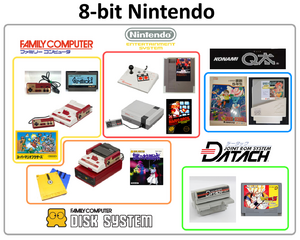FamiWiki:Policies and guidelines
FamiWiki's policies and guidelines are developed by the community to describe best practices, clarify principles, resolve conflicts, and otherwise further our goal of documenting 8-bit Nintendo and 16-bit Nintendo hardware, software, media, and everything else related.
Policies
Image policy
- Screenshots for Family Computer and Nintendo Entertainment System software must use the provided FamiWiki palette file.
- Resolution must be 256 x 240 with zero cropping.
- All screenshots must be in the .png format.
- Name images accordingly (e.g. Game Name FC TitleScreen.png, Game Name FC Box Art.jpg)
- The file name should not contain the following characters: ! ? \ / : " ' | -
- Make sure to include sources by filling out the source section in the upload field. (e.g. Imported from Wikipedia)
Terminology
Dictionary
- 8-bit Nintendo - Hardware that encompasses the Family Computer and Nintendo Entertainment System.
- 16-bit Nintendo - Hardware that encompasses the Super Famicom and Super Nintendo Entertainment System.
- Add-on - A hardware accessory or peripheral to expand the capabilities of the console by enhancing its features and functionality.
- Bootleg - An unauthorized or illegal copy of a product produced and distributed without the permission of the copyright holders.
- Cassette - Japanese term for cartridge.
- Console - A computer designed to play software made for it.
- Controller - An input device designed for particular hardware.
- Emulation - Imitating the functions of the target hardware to other hardware.
- Kusoge - Japanese abbreviation for "shit game".
- Licensed - Granting permission, authority, or rights for use for something.
- Nintendo Hard - Term for extreme difficulty.
- Platform - An ecosystem that encompasses the software designed for specific consoles.
- Port - Software made to work on different hardware.
- Reproduction - Duplicates or copies of the original.
- Unlicensed - Without proper permission or authorization.
Acronyms
- FC - short for Family Computer (or Famicom)
- FDS - short for Famicom Disk System
- NES - short for Nintendo Entertainment System
- SFC - short for Super Famicom
- SNES - short for Super Nintendo Entertainment System
Scope
Topics within the scope include anything related to 8-bit and 16-bit Nintendo history. This includes development history, hardware, software, staff and personnel and other things such as advertising media. Topics outside the scope generally include hardware and software created for the Nintendo 64 and beyond. While remakes such as the 2006 Final Fantasy III for the Nintendo DS should only be given a mention, emulated re-releases and ports of software within the scope is to be documented, such as Nintendo Switch Online.
Current Focus
- Creating Nintendo Entertainment System software pages.
- Creating Family Computer Disk System software pages.
- Creating Super Famicom software pages.
- Creating Super Nintendo Entertainment System software pages.
Resources
The following is a list of useful resources to reference when editing on FamiWiki.
- Famicom Database
- Famicom manual scans
- Famicom cartridge scans
- Super Famicom Database
- The Cover Project
- Gaming Alexandria
- LaunchBox Games Database
FAQ
General FAQs
Isn't the Famicom just an NES?
- FamiWiki treats both the Family Computer and Nintendo Entertainment System as two separate consoles. They do however fall under the same general platform we refer to as 8-bit Nintendo. The same applies with the Super Famicom and Super Nintendo Entertainment System under 16-bit Nintendo.
- The reason we have these consoles separated is to avoid confusion as to what software released on what console. Most websites list Famicom and Super Famicom software as NES and SNES software which can create false and misleading ideas which FamiWiki aims to avoid. We hope to set a standard for properly sorting between these consoles.
What perspective does FamiWiki go with within the scope?
FamiWiki primarily focuses in the context of Japan. In cases where that is not possible such as if software did not release in the country or particular events are relevant outside of the country then it's determined in a case by case basis. Generally though the order is as follows.
- Japan, North America, Europe, Australia, Taiwan, and Hong Kong.
Articles
What names do you use for software?
- Full name present on the game box (e.g.God Slayer: Haruka Tenkuu no Sonata instead of simply God Slayer). Shortened, recognizable names can redirect to the longer article name.
- Original Japanese romanized into English. Localized names are used for redirects.
- Words written in kanji (伝説, 逆襲) should be written with Wāpuro rōmaji (densetsu, gyakushuu).
- Words written with katakana (マリオ, デビル) should be written into its proper romanized "loanword" form (Mario, devil).
Do we use the terms manga and anime?
While FamiWiki is primarily written in English, the meaning for both terms vary depending on where people live. For this reason, FamiWiki uses general terms such as comics and cartoons instead. For example, Doraemon is a Japanese comics and cartoon series.
Disk or Disc?
- Disk for floppy disk media, Disc for CD media.

